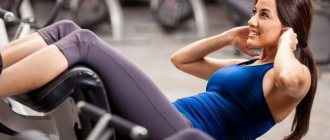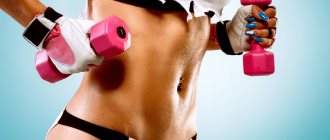Life doesn't end at 50 or 60! Many older men and women want to improve their figure or simply lead an active and healthy lifestyle. Let's try to figure out what you need to focus on to keep yourself in great shape.
It would be worth repeating that physical exercise is important at any age , and an active lifestyle as you get older is a great way to maintain health, prolong life and avoid possible illnesses. More and more older people are becoming involved in various sports, from athletics to the gym. You don't have to be young to be active and enjoy life.
Undoubtedly, training for older people should be different from training for young people and teenagers. Although no one is saying that such people are physically incapacitated, just certain movements should be avoided.
Before drawing up a training plan, you should consult with a medical specialist familiar with your personal medical record - this advice applies to everyone without exception. Older people are at greater risk for health, such as osteoporosis or arthritis. Consulting with your doctor is the first step.
Once your medical issues have been resolved, you may be unsure where to start. Fortunately, the American College of Sports Medicine (ACSM for short) has developed some basic guidelines for creating exercise programs specifically for older adults.
The main recommendation is at least 30 minutes of “moderate physical activity” at least 4 times a week. And although it may seem strange, strength training should be a priority because it prevents osteoporosis and muscle loss. In addition, flexibility exercises and functional movements (simulating everyday activities) are important.
The sample plan below includes four days of cardiovascular training and two days of strength training. If you experience discomfort or pain during exercise, stop immediately and consult a trainer or medical professional. Also, always have water on hand.
Features of training for mature women
Physical activity has always been considered the key to youth and longevity. For women after 50 years, strengthening muscles and ligaments becomes a necessity - special exercises will not only keep your figure in good shape, but will also prevent many diseases of the musculoskeletal system. Regular exercise will also help slow down the signs of aging and kick-start your metabolism.
At this age, you need to carefully approach the choice of exercises and training intensity so as not to get injured due to an incorrectly selected load or harm the cardiovascular system. Before you start doing a set of exercises for weight loss, read a few recommendations:
Before any physical activity (be it full-body exercises, race walking or running), do a short stretch. Slightly stretch the muscles of your neck, arms, and legs. This way you will protect your joints from injury and prepare your body for further stress.
- Don't make any sudden movements. All movements must be measured and clear, observing the correct technique.
- Don't forget about proper breathing. When you make an effort and tense your muscles, exhale. When you return to the starting position, inhale.
- Rest between each exercise should last from 30 seconds to 1 minute (to restore breathing).
- Don't forget to drink water during your workout. Take a few small sips between exercises.
Fitness after 50
Representatives of the generation of the 60s began to visit fitness centers en masse
More and more fitness centers are doing everything possible to attract older people - and they are succeeding, people over 50 years old make up the fastest growing segment of fitness club clients.
| According to the International Association of Sports, Health and Tennis Clubs, seniors are joining gyms in record numbers. The number of club cardholders over 50 grew by 343% from 1987 to 2003, while the number of club members aged 35 to 54 grew by only 180%. |
What is the reason for such changes? The point is that people just want to stay active in their older years. And they realize that this can only be achieved by keeping themselves in good physical shape.
Many of the problems we associate with aging actually have nothing to do with it. They are associated with poor lifestyle choices, and older people are finally starting to realize that, “Hey, we can fix this.”
Indeed, scientists are proving that this is quite possible. In a study published in the journal Neuroscience, doctors found that exercise can slow cognitive decline—meaning we can stay mentally sharp longer.
“No matter what the problem we're talking about, whether it's heart disease, obesity, diabetes, high blood pressure or osteoporosis, research shows that staying fit as you age will help you stay healthy and active longer,” says Cedric Bryant, Ph.D. Chief Exercise Science Instructor for the American Council on Exercise.
And seniors aren't about to miss this opportunity, experts say.
“Unlike our grandparents, who simply hoped they would live long enough to collect Social Security, our generation really hopes that we'll be doing the same thing at 60 as we were at 45—and it's quite possible that That's how it will be," says Witherspoon.
Fitness for those over 50: What you should know
Even if you're completely prepared spiritually, experts say, your body needs extra attention if you're going to get both the temporary and long-term benefits from exercise.
Some experts have expressed concern that not all gyms or health centers are suitable for older adults.
“Of course, we have recently seen a growing interest among older people in playing sports, but, unfortunately, the staff and instructors of gyms and sports clubs are not quite ready for such changes,” says Robert Catalini, exercise therapy instructor and director of the Holy Redeemer sports and fitness center at Holy Redeemer Medical Center in Meadowbrook, Pennsylvania.
This is especially important for those who have not exercised in the past or have been sedentary in recent years, he says.
"The longer it's been since you last visited the gym, the more you'll have to trust the instructors to tell you the right exercises, so it's important to know what they're doing," says Bryant.
What's more, says Catalini, if you already have health problems - such as sore joints or knees, back pain - and are at risk for heart disease, such as high blood pressure, high cholesterol or obesity, you should be even more confident is that you get the right advice.
“The question is not whether you should do it, of course you should, you just need to pay attention to certain things and follow certain recommendations, and of course these recommendations cannot be the same when you are 20, 30 or 40 years old,” says Catalini.
7 ways to achieve success
To help you get on the path to an active, healthy future, Bryant and Catalini offer 7 tips that will ensure the success of your fitness plan.
- Ask questions, especially if you are worried about your health: Can you help me with my bad back, do you have instructors who specialize in cardio exercises, is your pool heated and to what temperature? You should find out all the details that may affect your health before you sign up for a particular program. Also make sure your instructor has experience working with non-athletes over 50 years of age.
- Make sure your trainer, club manager or fitness instructor reviews your medical records and family medical history before developing your exercise program. You must also complete a physical activity readiness questionnaire or take the PAR-Q test to determine your physical
age, which may not be the same as your chronological age. Exercises should be designed based on physical age.
- Tell your fitness instructor about your health problems (for example, if you have asthma or heart disease) or risk factors (if you smoke, have frequent shortness of breath, or have ligament problems), and any medications you take . Some of them can cause fatigue, muscle pain and other symptoms that can be mistaken for the effects of exercise.
- Clearly define your goal and indicate it to the instructor or club manager. Do you want to lose weight, become more energetic, get rid of pain or strengthen your joints? Make sure that in this wellness center you will achieve your goal.
- Don't try to be on the same level as the younger members of your group or measure yourself up to your past achievements. The worst thing you can do, experts say, is to focus on your years as the quarterback of your high school football team and try to do the things you could do years ago. Set new goals that are age appropriate and challenge yourself only in real time.
- Before you start working out at the gym, get a medical checkup, no matter how well you feel. Tell your doctor about your plans and discuss possible restrictions with him. Consult your doctor any time you experience significant discomfort during exercise, including shortness of breath, chest pain, headache, dizziness, or muscle pain that does not improve after one or two days of rest.
- Listen to your body, not your coach. When you are young, you can exercise actively and for a long time. But when you're over 50, the best goal is consistency. If your body asks you to slow down, then slow down. And period.
Exercises without equipment
So, let's move on to a set of exercises for women after 50 years - such a full-fledged workout is performed at home and does not require additional equipment. And it will use the muscles of your entire body! The technique of each exercise is described step by step and supplemented with visual photos.
- Exercise No. 1. Take a lying position, lying on your back. Bend your legs at the knees, arms at your sides. The body is tense - the stomach is tucked, the buttocks are slightly compressed. Slowly raise your straightened right arm and move it back. In this case, you do not touch the floor. Just as slowly return it back to the starting position. Repeat with the second hand, alternating them. And make sure that your shoulder blades and lower back are pressed to the floor! Do 20 times.
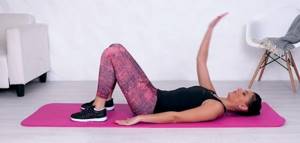
- Exercise No. 2. Stay in the same position, but now move both hands behind your head and leave them suspended. Do low-amplitude swings - either bringing your straight arms closer to the floor or moving them away. At the same time, keep your hands elevated and do not touch the floor. Do the movement 20 times and relax.

- Exercise No. 3. We remain lying on our backs, legs bent at the knees. Straighten your right leg, holding it in the air for just a couple of seconds. Then pull it towards your stomach as much as possible. And after that, return to the starting position (in which the left leg remained). Repeat with the opposite leg. Each time you change legs, do the movement 20 times.
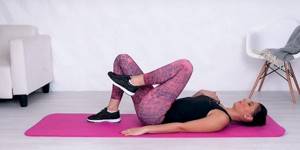
- Exercise No. 4. Starting position: lying on your back. Bring both knees towards your chest. The abdomen is pulled in, the lower back and pelvis are clearly fixed on the floor. Spread your knees to the sides and bring them back. Do 25 times.

Interesting: Back stretching exercises
- Exercise No. 5. Lie on your back, bend your knees, and place your hands at your sides. Raise your pelvis above the floor, resting on your feet and shoulder blades. It's like making a bridge. Pause at the top for 1-2 seconds and return your hips to the floor. Repeat 10 times.
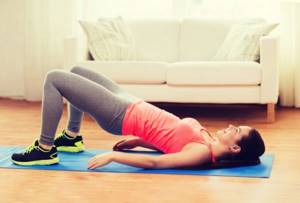
Exercise helps to work the abdominal muscles
- Exercise No. 6. Take a “on all fours” pose. Extend your right leg back while simultaneously extending your opposite arm forward. So that the back forms a straight line with them. Return to the starting position and do the same with your left leg and opposite arm. Doing these movements alternately, perform the exercise 20 times.

- Exercise No. 7. We stand straight, feet slightly apart from each other. Make a leg swing - first pull one leg towards the opposite hand, and then the other leg towards the opposite hand. Perform the exercise 20 times alternating legs.

- Exercise No.8 Bend your body to the side, placing your hand behind your head. Lean alternately to the right and then to the left. Do 20 times.
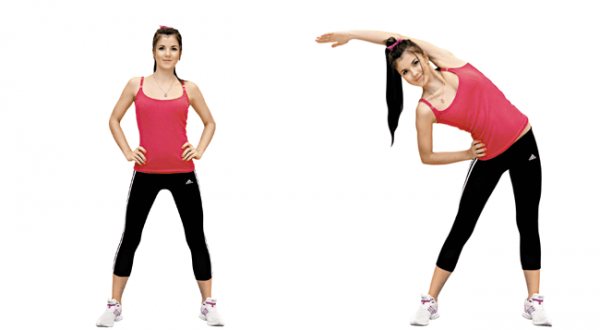
Types of training
It is better for 50-year-old people to give preference to the following types of activities:
- Water aerobics and swimming. When swimming, all muscle groups are used. Due to the fact that movements occur in water, they are safe. It is impossible to get injured. Water aerobics classes are good because they do not strain your joints due to the fact that all actions are performed in water.
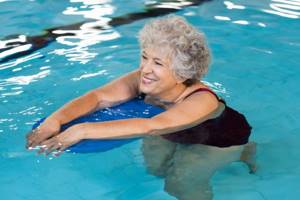
- Yoga for joints is simply irreplaceable. It is worth starting with simple asanas and then moving on to more complex ones.
- Walking is the most accessible form of exercise. A person engages in walking in the fresh air, which has the most beneficial effect on health.
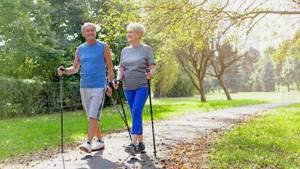
- Pilates helps you burn calories without harming your health.
- Aerobics also gives excellent results if done correctly.
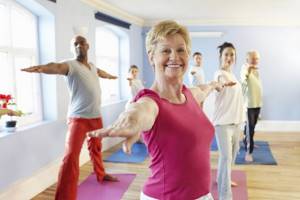
And at the age of 50 you can do fitness. You just need to take all precautions.
Exercises with dumbbells
This is a more advanced workout that is not suitable for beginners. But if you were familiar with physical activity before, feel free to move on to these exercises. Thanks to the additional weight (dumbbells), you can better work every muscle in your body and lose weight faster. For training at home, small dumbbells weighing 1-2 kilograms will be enough.
Interesting: Exercises for back and lower back pain
- Exercise No. 1. Get into a stable standing position. Stretch your arms with dumbbells up and then bend your elbows to form a right angle. Turn your body first to the right, while simultaneously throwing your left arm up. Then return back to the starting position. Turn to the left, extending your right arm and turning back. Make 7 movements in both directions.
- Exercise No. 2. Starting position: standing, arms extended along the body. Raise both straight arms forward, bringing them in a straight line with your chest. Then lower it. Do 8 times.

- Exercise No. 3. Stand up straight, holding dumbbells in both hands. Gently tilt your body with straight arms so that the dumbbells are just below your knees. At the same time, the back is straightened, the stomach is tucked. Return to the starting position. Number of repetitions: 10.
- Exercise No. 4. We stand straight, feet shoulder-width apart. Bend your torso to the side, as if sliding dumbbells along the side of your leg. Then take the starting position and do the same movement on the opposite side. Do 12 times.
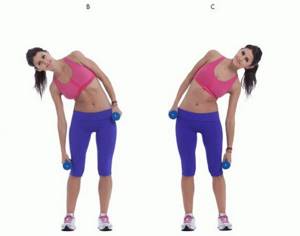
- Exercise No. 5 We remain in a standing position, legs are located far from each other, dumbbells lie between them. Bend over the dumbbells, take them in your hands and straighten up. Then return the dumbbells to the floor using the same tilt. At the same time, tense the muscles of your legs and buttocks, not your back. Do it 10 times.
Interesting: Exercises for losing weight on thighs and thighs
- Exercise No. 6. Let's finish the workout by working the abs - without dumbbells. We lie down on the floor, legs bent at the knees, hands locked behind the head. Raise the upper part of the body slightly, lifting it off the floor by 3-4 centimeters. Return to the starting position and relax your muscles. Do 10 reps.
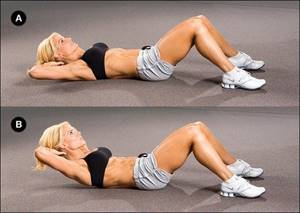
Such training is not dangerous and does not create unnecessary pressure on the spine or joints. The entire load in them is balancedly distributed throughout the body. Save these useful exercises for yourself and perform them regularly at home. For women over 50 years old, 2-3 such full-fledged workouts per week will be enough.
How do you keep fit as an adult?







